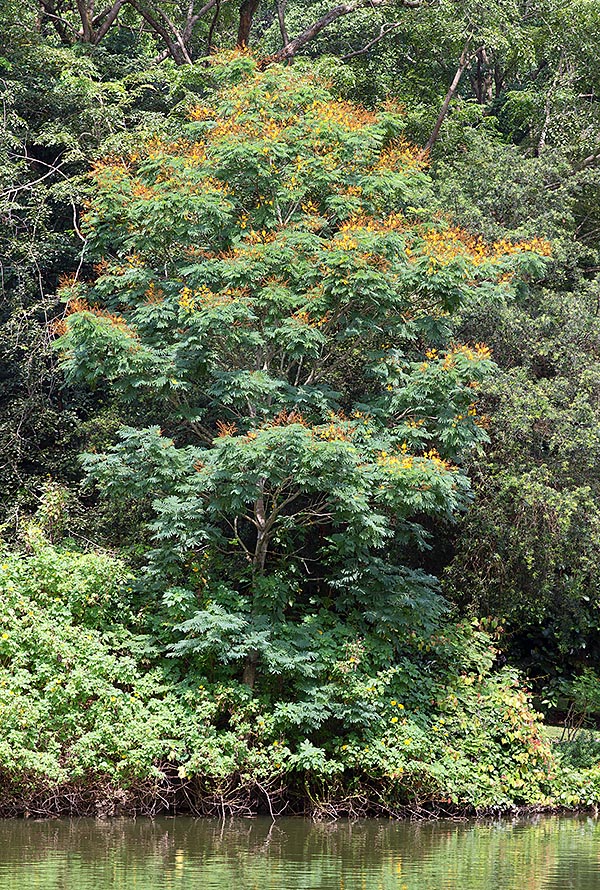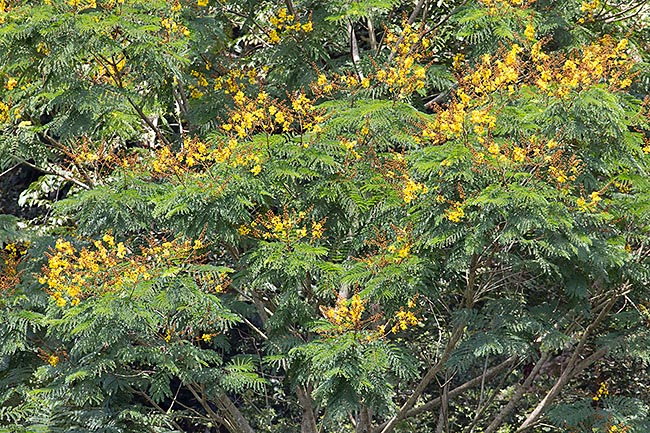Family : Fabaceae

Text © Pietro Puccio

English translation by Mario Beltramini

At home in South-East Asia, Peltophorum pterocarpum reaches 20 m of height © Giuseppe Mazza
The name of the genus comes from the combination of the Greek substantive “πέλτη” (pĕltē), which indicated a small shield shaped like a crescent, and of the verb “φορέω” (phoreo) = to carry, with reference to the peltate stigma; the name of the species is the combination of the Greek substantives “πτερόν” (pterόn) = wing and “καρπός” (carpόs) = fruit, with obvious reference.
Common names: copper pod, golden flame, yellow-flamboyant, yellow-flame, yellow flametree, yellow poinciana (English); tramkong, trasek (Khmer); framboyan amarillo (Spanish-Cuba); jamerelang laut, siar (Tagalog); kaju suga (Javanese); kondachinta, ivalvagai, peela gulmohar, perungondrai (Hindi); soga (Indonesian); dom trosek (Lao); batai, jemerelang (Malaysian); konyaivakai, perungkonyai (Sinhala); no si, saan ngoen (Thai); lim vangh, trac vang (Vietnamese).
The Peltophorum pterocarpum (DC.) K.Heyne (1927) is a tree, deciduous for a short period, unarmed, 4-20 m tall, with a dense umbrella-like canopy and trunk of 40-60 cm of diameter with greyish bark and young branches covered by a rust coloured tomentum; it has a deep radical apparatus and is capable to fix the atmospheric nitrogen, thus enriching the soil.
The bipinnate leaves, on a 5-7 cm long robust petiole also covered by a rusty coloured tomentum, are spirally arranged, 20-40 cm long, with 7-16 pairs of opposite bipinnate leaflets, 8-12 cm long, each having 10-18 pairs of oblong-trapezoid close leaflets with obtuse apex, 0,8-1,6 cm long and 0,3-0,6 cm broad, coriaceous, of dark green colour above, pale green below.
Terminal or axillar panicle inflorescences, erect, up to 40 cm long, carrying a crowd of bisexual flowers, opening in succession starting from the base, with pleasant scent and rich of nectar, with oval, about 0,7 cm long, sepals, 5 obovate petals, fringed, of luminous yellow colour with reddish brown spot at the centre, 1,8 cm long and 1 cm broad, and 10 yellow, 1,2 cm long stamina, densely hairy at the base, with orange anthers; peduncle, rachises, pedicels and sepals are covered by rusty coloured tomentum.
The fruits are elliptic to oblong compressed legumes, winged, 5-10 cm long, with about 0,4 cm broad wings, auburn when ripe with the time turning blackish, persistent for long time on the plant, containing 2-4 flat oblong seeds, about 1 cm long and 0,4 cm broad, particularly hard.

Very diffused in the tropical parks and gardens, it has even 40 cm long bright inflorescences © Giuseppe Mazza © Giuseppe Mazza
Very diffused in the tropics in parks and gardens as isolated specimen or in group and for road trees, is utilized also as shade tree in the coffee and cocoa plantations. Young specimens can be cultivated in pot, also as bonsai, in particularly draining loam and in as much as possible luminous position, with lowest temperature values never under the 15 °C. The leaves are used locally as fodder and from the bark, rich in tannins, they get a yellowish brown dye utilized in Java for colouring the textiles; the reddish brown wood is used in the constructions, for furniture, fixtures and boats, as well as fuel. Bark and flowers extracts are utilized in the traditional medicine for various pathologies.
Synonyms: Inga pterocarpa DC. (1825); Caesalpinia inermis Roxb. (1832); Poinciana roxburghii G. Don (1832); Caesalpinia ferruginea Decne. (1834); Peltophorum ferrugineum (Decne.) Benth. (1864); Caesalpinia glenieii Thwaites (1864); Peltophorum inerme (Roxb.) Náves ex Fern.-Vill. (1880); Brasilettia ferruginea (Decne.) Kuntze (1891); Baryxylum inerme (Roxb.) Pierre (1899); Peltophorum roxburghii (G. Don) O. Deg. (1938).
→ To appreciate the biodiversity within the family of FABACEAE please click here.
